Home | Front Page | Index | Blog | New | Contact | Site Map
Arizona | FotoShow | Photos | Map
Allen & Barbara
Heard Museum
Deer Valley
Casa Grande
Yuma
Old Towns
Indian Sites
Mongollon Rim
Petrified Forest
Painted Desert
Canyon de Chelly
Monument Valley
Navajo Monument
Glen Canyon
Grand Canyon
Flagstaff
Wupatki
Montezuma Castle
Oak Creek Canyon
Sedona
Tuzigoot
Tucson
Tubac
Tumacacori
San Xavier Bac
Organ Pipe NM
CactusTrails
Fujitsu Wars

Virginia
North Carolina
South Carolina
Georgia
Florida
Alabama
Mississippi
Louisiana
Texas
Arizona
California
Nevada
Index 1999-2002
Index 2003-2004
Index 2005-2006
Index 2007-2008
Index 2009-2011
Our first impression of Yuma was that it was a very small place with an inexplicably large number of motels. After we asked some questions and began to notice that there were also lots of RV parks we knew the secret: Large flocks of snowbirds migrate to Yuma each year. Apparently many Canadians and northern Americans like the place a lot. We spent two nights in Yuma, and the day in between was spent driving out past the Yuma Proving Grounds to the Imperial Dam, a blast from Gerry's grade school past. It took us quite a while to locate the dam and when we did it was a bit of a letdown compared to the Hoover dam, which we had visited twice together, and the Glen Canyon dam that was yet to come.
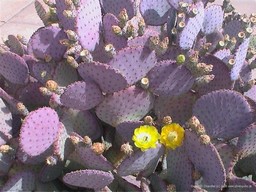
Cactus Flower |
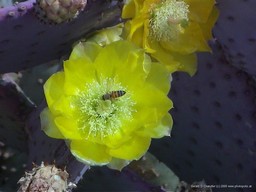
Cactus Flower |
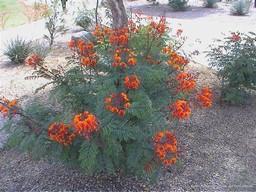
Cactus Flower |
It has to be said that our impression of Yuma was principally one of heat. A true desert experience, we thought, not yet having experienced June in Death Valley or July in Phoenix or even August in Hermosillo. Our experiences were not entirely unfounded, however, given that on the way out of town we spent an hour clambering around the Buttercup sand dunes. The heat is not too surprising when you know that Yuma is Arizona's low point at 43 meters (141 feet).
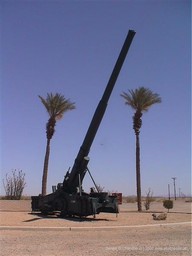
Yuma Proving Ground |
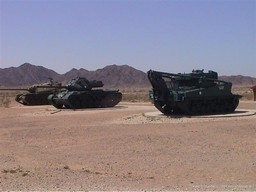
Yuma Proving Ground |
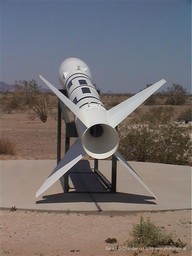
Yuma Proving Ground |

Yuma Proving Ground |
Our first excursion was to the Yuma Proving Grounds which surprisingly Jan had heard of and Gerry not. There isn't much to see there. A handful of old military hardware sitting out in the middle of the desert to commemorate the testing (proving) work done there during the second world war. Jan thinks she must have heard of it from our neighbor Harold Ryder who was a civilian employee at Fort Monmouth involved in creating and testing highly resistant electronic equipment for the military. A small exhibit told about the WWII use of the area as a training camp for desert warfare, particularly in North Africe. One letter and a poem described the hardships of life. It was said that after a solder died and went to hell he would come back to Yuma for blankets because by comparison hell was too cold. Gerry thought of how tough this was compared to the Japanese evacuees life in camps in Calfornia and how they get much sympathy while the hardships and dangers of the soldiers are often unmentioned.
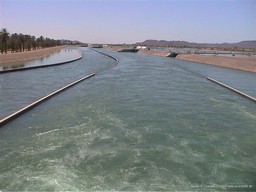
All American Canal |
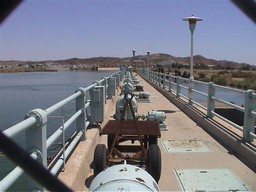
All American Canal |
Next stop was the Imperial Dam, which we had the hardest time finding in spite of maps and road signs. What we did find, however, were some fantastic Imperial Valley dates. Yes, that is Imperial Valley, California. We crossed the state line while looking for the Imperial Dam.
When we did finally find the dam, it was a little bit of an anti-climax. It is a rather low dam, by western standards, looking more like a weir than a dam. Its main purpose is to feed the All-American canal, so named to emphasize the fact that with the Gadsden Purchase the canal is entirely in U.S. territory. And that is where the interest of the dam lies. To protect the canal from silting and keep the water as clean as possible, the dam is fronted by large ponds so that silt can settle out and not be carried into the canal system. In addition to that there is a giant screen in front of the sluice gates where all kinds of debris are caught and removed frequently by an ingenious scraping device operated from a train that runs along the top of the dam.
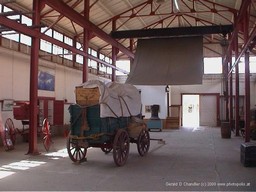
Covered wagon, Yuma Crossing S. P. |
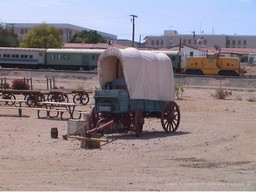
Covered wagon, Yuma Crossing S. P. |

Old Train, Yuma Crossing S.P. |
On our way out of town the next day, we came across the Yuma Crossing State Park. We stopped in expecting to stay half an hour and were surprised to spend an hour and a half and not exhaust our interest. The crossing referred to is the crossing of the Colorado River, of course. Before water was drawn from the mighty Colorado for irrigation, crossing its quarter-mile width could be a dangerous affair. So we learned about all the different people for whom this crossing point was critical: the local Yuma Indians who settled here first; the Spaniards of Mission San Pedro, built perhaps by our old friend Padre Kino, but destined for destruction by the local Yuma people, cutting it and northern Mexican territories from those of upper California; the would-be goldminers following the Gila trail en route to California; the engineers of the Southern Pacific Railroad and the builders of the All-American canal and other great Colorado basin irrigation projects, like the Colorado Siphon that carries canal water under the Colorado river here; and finally of course the modern-day snowbirds. Such a rich history for this desert outpost.
But finally we had to leave and get on our way to California.